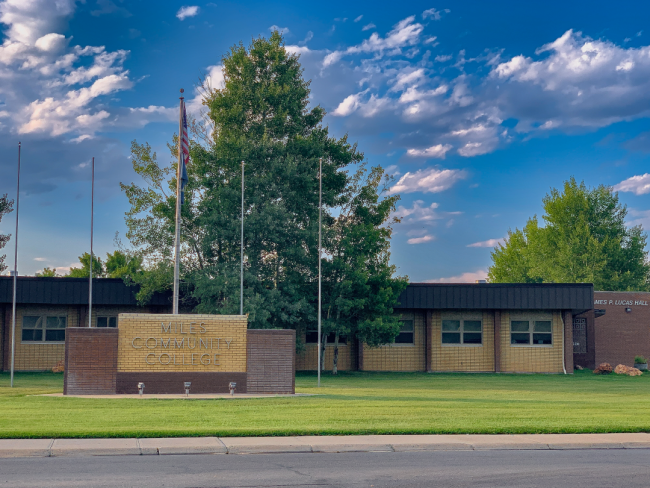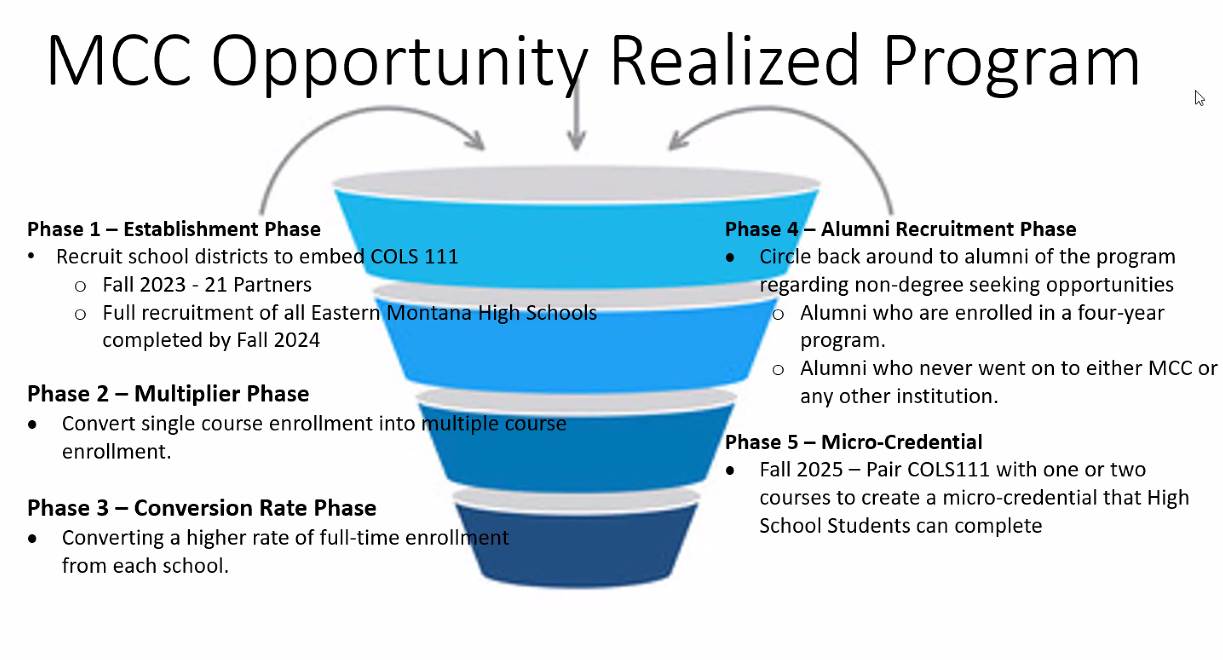You have /5 articles left.
Sign up for a free account or log in.

Miles Community College in eastern Montana wants to enroll every local high schooler in a one-credit online course focused on career and personal development.
Miles Community College
Miles Community College is a small, rural institution located about a mile off Interstate 94 in eastern Montana. It’s the only college in a 70-mile radius, enrolling around 500 students each term, around 43 percent of them dual-enrollment high schoolers.
Most high school students in this rural community don’t think they need college, explains President Ron Slinger, because their families have never gone to college and they plan to work on the ranch after they graduate.
This year, however, over 100 high schoolers in eastern Montana will have at least one credit from MCC, thanks to a new program that integrates career-preparation coursework into curricula.
The Opportunity Realized Program provides free dual enrollment to participating districts that enroll juniors and seniors in a one-credit online course focused on workforce development. The program, originally geared toward undeclared majors at the college, puts education on the radar of students who wouldn’t likely have otherwise enrolled and prepares them for future careers.
“It’s about giving that kid an opportunity to even think that there is something besides just the ranch or something in their community,” Slinger says.
What’s the need: In fall 2022, MCC leadership realized students who were unsure of how college fit into their life plans needed support.
“Our student athletes [were] coming to college and not really knowing what they wanted to do other than play ball,” says Richard DeShields, dean of student engagement and auxiliary services.
After launching the course, administrators identified a need beyond undeclared students for postcollege exploration.
The Montana Chamber of Commerce has a 10-year strategic plan that identifies workforce readiness as a focus area across the state. A 2019 survey of business leaders identified a lack of available skilled workers, primarily in entry- and midlevel positions, and a majority (69 percent) of respondents believe Montana schools are not adequately preparing learners for the workforce. Three in four business leaders believe career advising should be strengthened in middle and high school, as well.
The Bigger Picture
Nationally, high school students experienced difficulties in their education due to remote instruction during the COVID-19 pandemic. While the lasting impacts of pandemic-related learning loss have yet to be determined, recent high school graduates have more mental health issues and less confidence in their postsecondary success than earlier graduates.
A July survey from ACT found the pandemic affected students’ career choices (31 percent), program of study or major (27 percent), and whether to attend college (12 percent). Low-income students were more likely to report changes in thought, with 42 percent evaluating their future career, 39 percent rethinking their major and 20 percent considering whether to attend college.
ECMC Group’s January survey found 35 percent of high school students do not believe postsecondary education is necessary for success, and 63 percent are open to paths other than a four-year degree. But only around one in 10 (13 percent) students feels prepared to choose their path after high school.
How it works: The course, COLS111, is one part career exploration and one part interpersonal skill development, DeShields explains.
First, students learn to use the Montana Career Information System to identify occupations that align with their personal interests. Students also create a résumé and cover letter that they submit to a relevant job posting related to their career interests (even if they’re not qualified at this time) and complete a mock interview over Zoom with local business leaders.
Throughout the course, students learn emotional intelligence, time management, effective communication, conflict resolution, teamwork, professionalism, networking and problem-solving, all skills identified in the Montana Chamber of Commerce report.
The class is taught by MCC faculty members, but course delivery varies by the participating high school.
At the college, the course is in a HyFlex model once per week for one hour, with students able to participate in person, online or asynchronously. At high schools, the course is entirely online and asynchronous, but some teachers carve out time within their classes to work with the students on completing the modules, while others assign it during study hall hours.
Who completes the course also varies by school. For example, Sidney High School in Sidney, Mont., in integrated the class into its workforce pathway, with around 30 students enrolled each semester. Other schools have made it a requirement for graduation for seniors, and some add it to junior-class curriculum.
Creating a pipeline: The course offering is free for all participating high schools and their students, which was intentional as part of a matriculation strategy from MCC, Slinger says.
The goal is to make students aware of other relevant coursework and pathways at MCC that could complement their career goals. By fall 2025, college leaders hope to create a microcredential that pairs COLS111 with one or two additional courses.

Miles Community College administrators hope to create a pipeline of students starting with the one-credit course that evolves into full-time enrollment or re-enrollment for future reskilling.
Miles Community College
To offset costs, MCC in July received $34,500 in grand funding from the Montana Community Foundation to support the program’s development and $100,000 from a private donor.
Reaching rural learners: One of MCC’s biggest myths to bust among students is that postsecondary education doesn’t benefit them in their career ambitions, especially those looking at agricultural jobs or who would be first-generation college students.
“A student in our class, day one, he wrote, ‘I’m not going to college. School is for fools,’” DeShields says. “About the fourth class, in his assignment he wrote, ‘I think maybe I should consider looking at your CDL program, because driving a truck would help my family ranch.’”
By getting in front of students while they’re in high school, MCC leaders can encourage other dual-enrollment offerings, make alternative pathways accessible and maybe encourage completion of a degree or microcredential. Around 50 percent of high schoolers in Montana attend college, and that number shrinks to 25 percent in rural communities, Slinger explains.
“I think that’s a powerful message, that we’re changing the mind-sets of all these families,” Slinger says.
Scaling up: The first partnerships came from Slinger’s relationships with regional superintendents, and from there, the program has quickly spread between schools by word of mouth.
This fall, MCC has 21 partner high schools offering dual enrollment, with goals to spread to all 42 school districts in eastern Montana, DeShields says. More than 120 students have completed the course to date.
Business leaders have also expressed excitement at the program because it’s delivered universally across districts. “It does not matter your socioeconomic background; it does not matter who your parents are, where you grew up—you get this class,” Slinger says.
Moving forward, college officials are hoping to smooth out program logistics. “We’re kind of flying the plane as we go,” DeShields admits.
MCC is looking to hire additional instructors for the course as more schools come into the program. One school will add its entire senior class of 500 students to the program this fall—effectively doubling enrollment—and growing COLS111 from five sections to 25 or 30.
College officials also hope to invest in a customer relationship management system and other tech to enroll and manage students more efficiently as they look to onboard an additional 20 districts by 2025.
“It’s a pretty audacious goal to sit there and say we want every kid to go to college,” Slinger says. “I’m not saying to get a degree or certificate, but I want them all to go get this one class.”
Get more content like this directly to your inbox every weekday morning. Subscribe here.

b07d.jpg)

